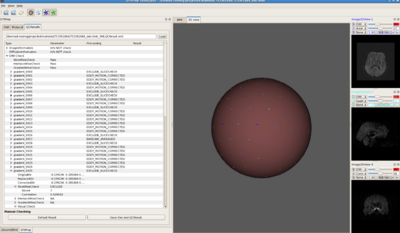Difference between revisions of "Projects:DTI DWI QualityControl"
| Line 10: | Line 10: | ||
DTIPrep as the first comprehensive and fully automatic pre-processing tool for DWI and DTI quality control can provide a crucial piece for robust DTI analysis studies. The protocoling, reporting, visual controlling and data correction capabilities are used to produce high consistence and inter-rater reliable QC results. This framework is organized by pipeline steps include: 1) image info checking, 2) diffusion info checking, 3) Slice-wise intensity checking, 4) Interlace-wise intensity checking, 5) Averaging baselines, 6) Eddy-motion correction, 7) gradient-wise checking, 8) Computing DTI measurements and saving. | DTIPrep as the first comprehensive and fully automatic pre-processing tool for DWI and DTI quality control can provide a crucial piece for robust DTI analysis studies. The protocoling, reporting, visual controlling and data correction capabilities are used to produce high consistence and inter-rater reliable QC results. This framework is organized by pipeline steps include: 1) image info checking, 2) diffusion info checking, 3) Slice-wise intensity checking, 4) Interlace-wise intensity checking, 5) Averaging baselines, 6) Eddy-motion correction, 7) gradient-wise checking, 8) Computing DTI measurements and saving. | ||
| − | As further extended-DTIprep, our experiments show that the residual artifacts presence after DTIPrep DWIs QC can be detected and corrected using knowledge of DTI. We introduce new entropy-based | + | As further extended-DTIprep, our experiments show that the residual artifacts presence after DTIPrep DWIs QC can be detected and corrected using knowledge of DTI. We introduce new approach in DTI QC including the ''detection'' and the ''corrections'' steps. Our approach use new entropy-based benchmark comes up with Principal Directions (PDs) histogram within different regions of brain. Given training of the measurement, the quality of DTI is categorized into acceptable, suspicious and unacceptable groups using calculated the standard scores. |
| + | |||
| + | |||
| + | |||
| + | We employ the correction step by excluding gradients which have the most contribution in the artifacts. We continue ex- cluding gradients till the z-score of whole brain of updated image will be close enough to the trained | ||
Revision as of 19:48, 3 November 2011
Home < Projects:DTI DWI QualityControlBack to UNC Algorithms
Diffusion Tensor and Diffusion Weighted Imaging Quality Control
DWIs data suffer from inherent low SNR, overall long scanning time of multiple directional encoding with correspondingly large risk to encounter several kinds of artifacts. These artifacts can be too severe for a correct and stable estimation of the diffusion tensor. Thus, a quality control (QC) procedure is absolutely necessary for DTI studies. We are developing a framework, called DTIPrep for assessing and correcting DWIs and DTI.
Description
DTIPrep as the first comprehensive and fully automatic pre-processing tool for DWI and DTI quality control can provide a crucial piece for robust DTI analysis studies. The protocoling, reporting, visual controlling and data correction capabilities are used to produce high consistence and inter-rater reliable QC results. This framework is organized by pipeline steps include: 1) image info checking, 2) diffusion info checking, 3) Slice-wise intensity checking, 4) Interlace-wise intensity checking, 5) Averaging baselines, 6) Eddy-motion correction, 7) gradient-wise checking, 8) Computing DTI measurements and saving.
As further extended-DTIprep, our experiments show that the residual artifacts presence after DTIPrep DWIs QC can be detected and corrected using knowledge of DTI. We introduce new approach in DTI QC including the detection and the corrections steps. Our approach use new entropy-based benchmark comes up with Principal Directions (PDs) histogram within different regions of brain. Given training of the measurement, the quality of DTI is categorized into acceptable, suspicious and unacceptable groups using calculated the standard scores.
We employ the correction step by excluding gradients which have the most contribution in the artifacts. We continue ex- cluding gradients till the z-score of whole brain of updated image will be close enough to the trained
Publications
Key Investigators
- UNC Algorithms: Mahshid Farzinfar, Zhexing Liu, Martin Styner, Clement Vachet
- Utah Algorithms: Tom Fletcher, Ross Whitaker, Guido Gerig, Sylvain Gouttard
Links
- DTIPrep on NITRC

